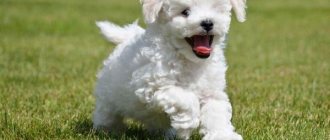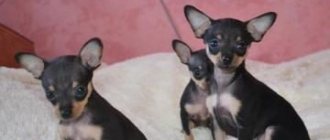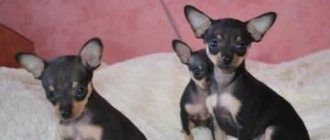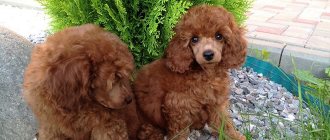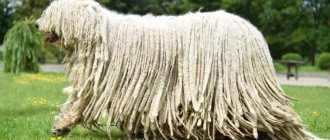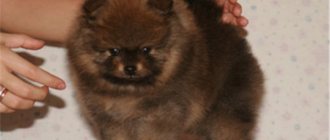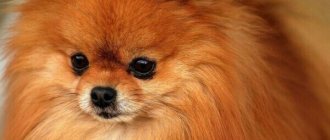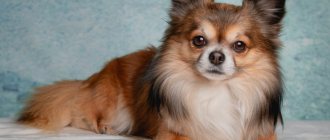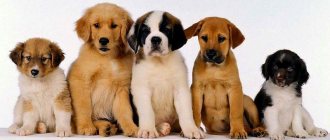The Brussels Griffon (Griffon Bruxellois) is a decorative breed of small lap dogs with an extremely unusual, slightly scary appearance. Recently, it has become increasingly popular due to its distinctive appearance.
- 2 Description of the Brussels Griffon breed
2.1 Appearance - 2.2 Character
2.2.1 Video: energetic griffon
- 3.1 Video: caring for the Brussels Griffon
- 5.1 Video: Griffon training
Description of the Brussels Griffon breed
Popularity 248th place among 263 dog breeds
Lifespan:
12-15 years
Breed group:
Decorative
Height:
18-20 cm
Country of origin:
Belgium
Average price:
20-35 thousand rubles
Weight:
3-6 kg
Latest articles Cat health
Rabies vaccination for cats: choice of vaccine, necessity, schedule 01/22/2022 4 0 0
Selection and adaptation
TOP 20 best cat breeds for families with children 01/22/2022 25 0 0
Pros and cons of the breed
Brussels Griffons are charming dogs with clear leadership abilities. To ensure that life with them brings only pleasant surprises, you need to analyze the advantages and disadvantages of the breed in advance.
| pros | Minuses |
| Extravagant exterior | Intolerance of loneliness |
| Miniature sizes | Difficult relationships with children |
| Goodwill | Tendency to dominate |
Brussels Griffons are miniature dogs with an unusual appearance and a cheerful, cheerful disposition. They will be ideal companions for moderately active people who spend a lot of time at home and are not burdened with small children.
Key facts
Sociability and activity are the main traits that describe the character of the Brussels Griffon. The animals constantly chase their owner and are sometimes annoying, but in a good sense of the word. Of the many family members, the dog pays special attention to only one person, and at first treats the rest with caution and even shows coldness.
The description of the Brussels Griffon breed includes excellent guard qualities, a high level of intelligence and good memory. Griffons remember different commands well and are easy to train. At the same time, the little dog gets along with his relatives and other pets in the house.
The kids clearly adapt to the mood and support any initiative of the owner. At the same time, they remain in a state of calm with ease. In order for your dog to treat guests well in your home, you need to socialize it from puppyhood.
The life expectancy of the Brussels Griffon is long for such a baby: it reaches 12-15 years.
Where to buy and price
Kennels where you can buy a Brussels Griffon:
- Gerald Griff (Moscow);
- Golden Grif (St. Petersburg);
- Mellis Stilla (Ekaterinburg).
The starting price of a puppy is 10,000 rubles. The standard cost is 15,000-40,000.
The Brussels Griffon can become an excellent companion not only due to its unusual appearance. First of all, he is valued for his high intelligence and great devotion. But it is important for future owners to take into account the peculiarities of keeping a pet in order to provide it with comfortable living conditions.
History of the origin of the Brussels Griffon
The breed first appeared in Belgium about two hundred years ago. The word "griffon" is translated from French as "wire-haired".
Agriculture flourished in Belgium. Seeds of grains and legumes were stored in many barns, where they were constantly eaten by rodents. The Belgians decided to take care of their supplies and bred a new breed of small shaggy dogs that could penetrate the smallest holes and eliminate wild rodents.
And in the second half of the 19th century, the privileged class - the nobility - paid attention to dogs. Even Queen Maria Henrietta admired the breed, which influenced the further spread of the Brussels Griffon throughout Europe.
The dog was often used to guard the crew, as it had a ringing bark that was hard not to hear.
After World War II, the number of dogs of this breed decreased significantly. Griffons were taken out of Belgium less and less often. A little later, they finally appeared in the United States and Great Britain, but there are few of them left in their homeland. Dog breeders put a lot of effort into breeding griffons, but the breed remained few in number.
In general, even now meeting a handsome guy from the “line” of griffons is a rare success.
History of the breed
The Brussels Griffon is native to Belgium. The first information about these dogs appeared more than two centuries ago. Since that time, this species has traced its history.
It all started with the fact that the owners of Belgian stables needed reliable protection against rodents. Rats multiplied quickly, destroyed buildings and were carriers of infectious diseases. Wire-haired dogs “Smousje” were used in the fight against rodents. They were small in size, but where they lived, rats were caught completely.
It was from Smousje that the Brussels Griffon and the other two types of Belgian small dogs (Petite Brabançon and Belgian Griffon) originated. The following species participated in the formation of the breed: pug, Ruby King Charles spaniel, Affenpinscher, Russian toy spaniel.
Each species has left its mark on both the character and appearance of the modern griffon. For example, the pug got its short muzzle, the spaniel got its head shape and expressive look, and the affen got its coat structure from the griffon.
As a result of the breeding work to improve the Brussels Griffon, the result was a dog with the talent of a real hunter. Its main purposes are the extermination of rodents, hunting small game and security escort of stagecoaches and postal carriages.
It is clear that the small dogs were not capable of fighting the robbers, but they instantly reacted to the slightest danger with loud barking. Thus, the owner had time to react to a possible attack.
Now the Brussels Griffon breed is considered rare, but its popularity is at the highest level. Let's trace the historical path of this type of dog by date:
- 1883 – The first representatives of the breed were entered into the Belgian Stud Book. A standard has been set. Griffons got the opportunity to participate in exhibition shows.
- 1889 - the first club of this breed was organized in the homeland of the Brussels Griffon.
- 1898 - In England, the Brussels Griffon is officially recognized as a separate breed.
- 1899 - The first Griffon Club was organized in America.
- 1900 - American cynologists officially recognized the Brussels Griffon as a separate breed.
- 1945-1946 – the Belgian breed was on the verge of extinction.
- Twentieth century (fifties-nineties) - the number of Brussels griffins is being restored. The breed is at the peak of popularity.
Appearance of the Brussels Griffon
General impression
These small animals belong to the breed of decorative dogs. The animals are stocky, a little stubborn and rough. The small dog is endowed with fearlessness and incredible agility. The dog's appearance is absolutely extraordinary - for many people it evokes associations with a wise old man. In the photo of the Brussels Griffon, the first thing that catches your eye is its non-standard muzzle.
Head
The head is rounded and looks disproportionately large in relation to the body.
Neck
The neck is distinguished by dryish muscles, it is strong and short.
Torso
The shape of the body is somewhat reminiscent of a square. The length of the body coincides with the height of the dog at the withers. The back is very muscular and strong, and the stomach is toned and elastic.
Forelegs
The limbs have prominent muscles and end in small rounded paws. The pads and claws are black.
Hind limbs
The thighs are powerful, the hocks are low relative to the ground.
Tail
The tail is set high, its tip almost always raised. In this breed, it is permissible to dock the tail a little more than half of its original length.
Movement
They move at a trot; when moving, their back is always straight.
Wool
The coat is medium length, rough to the touch. The hair around the nose, eyes and cheeks is longer.
Color
The colors of the Brussels Griffon include the following options:
- solid black;
- red with a small splash of black hair;
- beige-brown;
- black with small red specks.
Most often, spots are found on the beard and paws.
Size
The height of the Brussels Griffon at the withers for males is 27-33 cm, and for females - 25-31 cm. The weight of the Brussels Griffon ranges from 3.5-6.5 kg. We can say that these are pocket dogs, but the size of the Brussels Griffon does not quite correspond to its character. A brave and big heart beats in a small body.
Socialization
If griffons treat the owner’s relatives and friends coolly, then they are completely afraid of strangers or attack out of fear.
In order for the Brussels Griffon to grow up balanced and not rush at passers-by, you need to socialize your pet from puppyhood and introduce it to a large number of friendly people. Strangers who want to pet the fluffy one are politely asked not to do so.
Small children and the Brussels Griffon are not the best company either. The pets themselves will not attack the guys. But they will not tolerate being pulled by the tail and ears: they will snap or even bite your hand.
Brussels Griffons get along well with other pets. Moreover, they need a companion to play with, a cat or a dog - it doesn’t matter.
In relation to other dogs, griffons try to dominate. The description of the breed speaks of possible clashes between males against the background of sexual aggression.
Character of the Brussels Griffon
At first glance, the character of the Brussels Griffon is very stern and angry, but this impression is deceptive. If you get to know these kids better, it will become clear that they are very energetic, sociable and active.
Brussels Griffons love to be the center of attention: they are ready to do anything to get someone to show interest in them. But this should be treated with special caution: animals need to be well raised from a young age, otherwise they can grow up to be very demanding and capricious.
The breed will support any decision of its owner, be it a very early walk in the forest or a long journey. They always chase their owner, trying not to move even a step away from him. And after a long absence, they pounce on their beloved owner and begin to actively “kiss” him.
In a family, a griffon considers only one person its equal – its owner. Despite the fact that the animal needs increased attention, dogs do not mind being alone with themselves. The breed is not suitable for you if you are away from home a lot. Bearded men tend to impose themselves on their company quite often, and not everyone will like this.
There is an opinion that griffons do not require a long walk - this is true; a half-hour walk will be enough for the pet. But, if for some reason you linger in the fresh air, the animal’s happiness will know no bounds.
Socialization should be carried out from puppyhood, otherwise the animal will grow up unadapted to the environment and may show some aggression towards strangers. It is unlikely that a stranger will be able to touch it.
Brussels Griffons should not be kept in dog kennels. Animals are very curious, but at the same time quite careful.
Bravery is a trait that cannot be taken away from them. It is known that Belgian griffons have long hunted small rodents, so fearlessness and courage are inherent in the blood of every dog, even in an unforeseen situation.
Possible diseases
The Brussels Griffon belongs to small breed dogs, so they are characterized by almost all common diseases. The most common diseases are:
- Narrowing of the nostrils.
- Retinal atrophy.
- The presence of additional eyelashes.
- Cataract.
- The eyeball may fall out of the socket.
- Difficulty and problems with childbirth. In almost all cases, you will need the help of a veterinarian and a caesarean section.
- Dropsy of the brain.
- Hip dysplasia.
- Various dislocations. The kneecap is especially often affected.
- Allergy.
Therefore, the owner must closely monitor his pet. It is especially important to maintain a proper diet. If the owner of a griffin notices any deviations in the behavior or health of the dog, he should immediately consult a doctor.
Education and training
The breed is distinguished by its exceptional intelligence and good memory, so raising and training the Brussels Griffon will not create unnecessary problems. Even very young puppies understand what a person wants from them, so training can begin at the age of 2-3 months. But don't forget: griffons show signs of power in many situations. The breed is not suitable for people with a soft character.
You need to start training with the simplest commands, such as: “lie down!”, “sit!”, “fu!”, “impossible!” and so on. You should not raise your voice at the dog and show your displeasure. Good learning results should be rewarded with various treats and praise. During the training process, take advantage of qualities such as consistency and perseverance.
You can engage the Brussels Griffon in various sports - in particular, agility. During the obstacle course, the animal will not only repeat the commands it has already learned, but will also warm up a little.
Much attention should be paid to the socialization of puppies. From a young age, animals need to be taught to be friendly. Little griffons can be rewarded for playing with children and for being obedient. Each family member must provide care and affection to the pet. During your walk, give your dog the opportunity to interact with the environment and get to know passers-by. So she will understand that the outside world does not pose any danger.
Despite the fact that the griffon reacts calmly to everything, you should take care that passers-by do not touch it (at least at first). The dog may perceive such a gesture as an attack and begin to defend itself.
You can walk your pet from 1 to 3 hours. If it’s cold and damp outside, then 15-25 minutes is enough to relieve your natural needs. If you bred a griffon for the purpose of training, then it is better to first let it unwind and then begin the training process.
Key points of training
- During training, you should not try to “break” the animal’s stubbornness.
- In order for a griffon to do something, he must want it himself.
- Any violence will only embitter the dog and will not bring results. You need to work with the animal every day, but not for long, as this breed gets tired quickly. It is necessary to develop in animals such qualities that are inherent in them by nature, such as dexterity, attentiveness, activity and curiosity.
- Read about how to properly train a dog in the article: “Training a puppy: effective methods from dog handlers, learning commands at home.”
Health and diseases of the Brussels Griffon
Possible diseases
Animals have very strong immunity to viral diseases.
A number of specific diseases that occur in the breed:
- cataract;
- numerous complications during childbirth;
- loss of eyeballs;
- retinal atrophy;
- hydrocephalus;
- Perthes syndrome (necrosis of the femur).
The breed may also have certain defects. There is a possibility of having a defect that is characterized by a too short or elongated body. A common defect is slanted or light-colored eyes. A hunchbacked lower back and a flat or overly narrow head are very common.
There are also disqualifying defects of the breed:
- lameness;
- dislocated joints;
- malocclusion;
- deafness, blindness;
- brown nose color.
Regular walks, proper feeding regimen and timely vaccination will help keep your pet's health normal. You can eliminate the risk of buying a sick puppy if you go to a kennel with a good reputation.
Reproductive health
Before mating, the female must be dewormed and her fur treated for various parasites. It is very important for the health of the offspring that the bitch does not have any infections or diseases.
You should not breed the breed after the first heat - this can seriously harm your health. It is necessary to wait until the female’s body is completely ready to bear puppies. Pregnancy and childbirth take a lot of strength and a significant part of a bitch’s health. The third heat indicates that the female is completely ready for procreation.
If you want to make sure that your dog is fully prepared for pregnancy and childbirth, you can go to a veterinary clinic and take a vaginal smear. The most favorable days for mating are considered to be the middle of estrus.
Pregnancy lasts from 55 to 72 days. At first you will not notice any changes, but after about 40-50 days you will be able to observe the puppies moving. Approximately a week before the expected birth, protein should be almost completely eliminated from the diet.
A pregnant dog can and even needs to move a lot, but too active games should be excluded. Before giving birth, bitches change their mood and may grumble more than usual. They also try to hide in a secluded place.
To ensure that the birth goes well, you can invite a veterinarian to your home - this way you will ensure peace of mind for yourself and your pet. Contractions are most often short-lived, but sometimes last a whole day. During childbirth, the dog should not be left alone, because the health of the future puppies and their mother depends on timely assistance.
Distinctive features
Despite its small size and short stature, the griffon is distinguished by physical strength and endurance.
Here's how you can describe the appearance of this dog:
- The ears are small, high-set, and located far from each other. If the ears are not cropped, they are half erect and hang forward. When the ears are cropped, they become pointed and stand up;
- The tail is set high. When the tail is docked, it is shortened to exactly two-thirds of its original length. If the tail is not docked, it stands vertically, the tip is oriented towards the back, does not curl, just slightly bent. The tail is short and has a characteristic crease. If the tail curls into a spiral, this indicates that the dog is not purebred;
- The eyes are set wide apart and have a pronounced round shape. They are never convex. Eye color is usually brown. The dark brown color indicates the purity of the breed. The pupil has a black rim, the whites are practically invisible;
- Body - the neck is of medium length, almost merging with the body. The length of the body is the same as the height. The body has the shape of a regular square;
- Color – red or slightly reddish, light brown. There may be small dark, almost black spots on the head. There is a combination of black and red-brown color. In older animals, the mask may be pearly gray. There may be a small amount of white hair on the chest, but this is not encouraged at shows;
- The coat is hard, thick and short undercoat. Slightly frizzy. The fur above the eyes lengthens sharply, smoothly turning into the eyebrows.
- Nose – large, open nostrils with a wide bridge of the nose. The eyes and bridge of the nose are located on the same line. The nose tilts back slightly. In profile, it is on the same vertical line with the forehead and chin.
Features of feeding and diet
Proper and balanced nutrition is the key to good health. Therefore, special attention must be paid to the formation of the menu.
Griffon puppies under 3 months of age need to be fed 5 times a day. From 3 to 6 months – four meals a day are enough. In the interval of 6-12 months – 3 times a day. An adult dog is transferred to two meals a day.
What to feed the Brussels Griffon?
- If you are determined to feed your pet dry food, then you need to choose food for decorative breeds.
- Dry food should contain 15-20% more calcium than phosphorus.
- If you feed a griffon with natural food, then chicken and beef should make up at least 35% of the diet.
- With natural feeding, the diet should consist of 30-35% cereals and vegetables.
The natural menu of the Brussels Griffon should consist of raw or scalded meat, boiled sea fish without bones and cereals (oatmeal, buckwheat, rice). Experts advise supplementing the dog’s menu with seasonal fruits and vegetables, low-fat dairy products and quail eggs.
The following foods should be strictly excluded from your diet:
- spicy, salty, fried and pickled foods;
- fatty meat (lamb, pork);
- river fish (in any form)
- smoking;
- sweets;
- any berries with seeds;
- milk.
Serving sizes will depend on your friend's weight, age, and activity level. By and large, the breed is not picky about food.
Application
For as many years as Brussels dogs have been rat catchers, they have spent just as long basking in the arms of the nobility. Today they have lost their working qualities. But they became excellent companions.
Brussels Griffons are best suited for single people who are retired or working from home. Without constant attention and contact with their owner, they will become bored, nervous and frustrated.
Griffons are good watchmen. They will warn about the visit of guests and the approach of strangers. But only during the day. At night, pets rest, and sleep is sacred for dogs.
Maintenance and care
Griffons have a special coat. Careful care is a must. The dog needs to be brushed at least 1-2 times a week, and preferably more often. Representatives of this breed also need trimming - hair plucking. It is better to entrust this procedure to a professional.
Washing should not be done too often, as this will negatively affect the coat. Water procedures are sufficient no more than 1-2 times a month. Pay attention to the composition of the shampoo. It should not contain harmful aggressive substances. Also, since dogs' fur is quite coarse, apply shampoo thoroughly and rinse it off just as thoroughly. After bathing, dry your pet with a towel and make sure there are no drafts in the house.
It is important to know: the small folds of skin on the Brussels Griffon's face are a suitable breeding ground for pathogens. Be sure to inspect them after every walk or meal; if necessary, wipe them with a cloth.
Keeping and caring for the Brussels Griffon requires constant eye examination. Since they have a convex shape, small eyelashes can often get caught in them, which should be trimmed regularly.
The oral cavity requires no less attention. If the animal eats dry food, then cleaning the mouth can be done less often. It will be enough to intervene at intervals of 1-2 times every month and a half. If the griffon eats natural food, then the oral cavity should be examined regularly and a special toothpaste should be used to clean the teeth. To make your pet happy, buy him meat-flavored pasta.
Babies grind their claws down on their own, but sometimes this doesn’t happen, and they get a lot of discomfort from it. A way out of this situation would be a nail clipper for dogs. It is necessary to trim the claws with great care, without touching the blood vessels, so as not to cause pain.
When you take a puppy into your home, you need to accustom yourself to order if you do not want to lose a lot of things. Because of their curious habit of chewing things and hiding them, Brussels Griffons are often called little brownies.
The snoring of a griffon has the potential to be compared to that of a mastiff. This is due to the fact that dogs have a flattened muzzle. This makes your breathing too loud. For a good night's sleep, it is recommended to provide your pet with a private place away from your bed.
Breeding
It is very difficult to breed them. Most often, a cesarean section is necessary for a successful birth. The litters are small. Puppies, unfortunately, very often die in infancy.
Tips for choosing a puppy
You should be well prepared when purchasing a Brussels puppy. First, buy bowls, hygiene products, toys. Create a cozy corner for your pet. It is better to buy a puppy from trusted breeders. These are usually located in large cities. If you do not live in a big city, then be sure to think about your way home with a little friend.
Once you decide on the place of purchase, you should think about what gender your friend will be. Males are playful and more aggressive, while females are docile and friendly. But the bitch can create discomfort during estrus, and then there will be a problem with walking - it will be difficult to get rid of the “four-legged suitors”.
Once you decide on your gender, you can pay attention to specific candidates. The optimal age to buy a puppy is 1.5-2 months. Brussels Griffon puppies should be active, cheerful and in excellent health. Pay attention to the medium-sized animal and carefully examine it from all sides. You should not choose the plumpest one from the litter.
When you decide on a puppy, make sure that the breeder gives you all the relevant documents: a passport, vaccination certificate and documents that confirm its pedigree.
Mating
There are several varieties of Brussels Griffons, each with its own characteristics of color, anatomical structure of the body and muzzle . It is better to knit animals that look approximately the same. Before mating, you should study the pedigree of your partner. In no case should you carry out mating if the partner turns out to be not purebred or has serious breed defects.
Even if the dog meets all the standards, it is quite possible that the puppies will inherit the deficiencies that exist in the family. Suitable age for mating is one year (for a male), one year and three months (for a female). If the dog does not feel well, breeding should be postponed until complete recovery. Breeding dogs that suffer from acute or chronic infectious diseases can lead to the birth of puppies with serious defects.
Before mating, both animals need to be treated for worms and fleas (ticks, lice eaters), and vaccinated against rabies.
Animals should not be overfed on the eve of an important event . It should be kept in mind that an overweight bitch is less likely to conceive a puppy. There is no need to rush into mating. If you breed a female dog during her first heat, her immune system may be weakened and serious health problems may develop. It is better to let your pet get stronger and gain strength.
Health
Brussels Griffons are not the toughest toy dogs. But with proper care they live 12-15 years.
Life expectancy greatly depends on nutrition and living conditions. Pets that are fed from the table and not vaccinated will not even reach 8 years of age.
Diseases
The description of the breed speaks of the Brussels Griffon as a fairly strong dog, devoid of genetic pathologies. Most diseases are related to the structure of the skull and muzzle. These include:
- narrowed nasal passages;
- retinal atrophy;
- double row of eyelashes;
- cataract;
- loss of eyeballs;
- hydrocephalus.
The breed is also prone to allergies and excess weight. Brussels Griffon puppies are susceptible to eye inflammation - while eyebrows, beards and mustaches are forming on their faces, the hairs injure the eyelids and eyeballs.
Preventive measures
Brussels residents are resistant to infections - they almost never get colds. However, not a single dog can withstand dangerous viruses. Therefore, pets are vaccinated against:
- rabies;
- carnivore plague;
- leptospirosis;
- herpes virus;
- enteritis;
- adenovirus.
10 days before vaccinations, as well as every 3 months outside the vaccine schedule, pets are treated for fleas and helminths. Be sure to inspect the dogs’ ears and body after walks for wounds and tick infestation.
Walk
The advantage of Brussels Griffons is that they do not need long, exhausting walks. In inclement weather, you don’t have to take them outside at all: the pets go to the toilet in a diaper or in a litter box, and splash out their energy by running around the room with toys. But dogs love to walk. True, they won’t run much - after 15 minutes of active games they will get tired and return to their owner. The rest of the time during the walk they will calmly walk side by side.
Walk your pets twice a day for 30-60 minutes. It is advisable to go outdoors on weekends.
In cold weather, pets are dressed in warm overalls; in rain, waterproof blankets are recommended.
Bathing
Frequently washing Brussels Griffons is not recommended. Hard, wire-like wool gets dirty a little, cleans itself, and frequent bathing spoils the fur coat and skin.
Pets are washed once every 2-3 months. If necessary, you can do it more often, but no more than once every 2 weeks. After the bath, pets are dried with a towel; a hairdryer is not used. Make sure that Brussels Griffons are not in a draft and do not jump out into the street.
After walks, wipe the paws, face and belly with a rough wet cloth. In summer, dust settles on wool, and dirt settles in slush. It is impossible to predict how dirty the dog will get. Some griffons are clean and disdainfully avoid puddles, others are slobs and joyfully run through the mini-swamps left after the rain.
